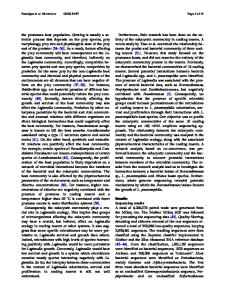Diatoms and Their Ecological Importance
- PDF / 339,953 Bytes
- 9 Pages / 504.567 x 720 pts Page_size
- 53 Downloads / 432 Views
Diatoms and Their Ecological Importance João Serôdio1 and Johann Lavaud2 1 Departament of Biology and CESAM – Centre for Environmental and Marine Studies, University of Aveiro, Aveiro, Portugal 2 UMR 6539 LEMAR, Institut Européen de la Mer, Plouzané, France
Definition Diatoms are unicellular or colonial photoautotrophic microalgae, eukaryotic organisms classified as protists of the group of the Bacillariophyta. They are characterized by the unique feature of possessing a cell wall made of silica. Diatoms form an extremely diverse and evolutionarily successful group. They are found in all marine and freshwater habitats and in moist terrestrial habitats, being the most diverse group of algae, the number of species being estimated to reach between 100,000 (Mann and Vanormelingen 2013) and 200,000 (Armbrust 2009). Diatoms have an enormous ecological importance, contributing to 20–25% of the Earth’s global primary production (Field et al. 1998; Sarthou et al. 2005). Their photosynthetic activity accounts for 40% of the marine primary production, being comparable to the total amount fixed by all the terrestrial rain forest combined (Armbrust 2009). However, their critical role in the functioning and
biodiversity of oceanic and coastal zones, while representing a major carbon sink and supporting important marine food webs, is threatened by ongoing climate change, namely, by ocean acidification and eutrophication. Introduction Diatoms are unicellular or colonial photoautotrophic microalgae. Diatom cells vary between a wide range of sizes, from 5 mm to above 1 mm in diameter or length (Sabater 2009). They are most commonly found as single cells but can form colonies, living in suspension in the water column or attached to substrata. Diatoms are found in all marine and freshwater habitats and in moist terrestrial habitats, covering extreme environments like sea ice (Arrigo 2014) or deep marine sediments well below the photic zone of the ocean (Cahoon et al. 1994). Diatoms are a major constituent of the phytoplankton in oceanic and coastal waters, where they often dominate over other groups of microalgae or cyanobacteria (Armbrust 2009). They are typically the dominant group in the microphytobenthos, the highly productive biofilm-forming communities of microalgae and cyanobacteria that colonize intertidal flats or shallow subtidal sediments (Underwood and Kromkamp 1999). Their ubiquity in virtually all marine habitats (Mock and Medlin 2012) and ability to strive in extreme habitats, such as polar systems (Lyon and Mock 2014) or under prolonged darkness (Frankenbach et al. 2019; Kennedy et al. 2019), is believed to be based on their
© Springer Nature Switzerland AG 2020 W. Leal Filho et al. (eds.), Life Below Water, Encyclopedia of the UN Sustainable Development Goals, https://doi.org/10.1007/978-3-319-71064-8_12-1
2
unique physiological and metabolic features (Wilhelm et al. 2006; Gruber and Kroth 2017). The Siliceous Cell Wall The most distinctive feature of diatoms is the presence of a silicified cell wall (“frustule”) made
Data Loading...











